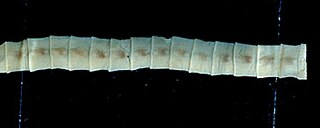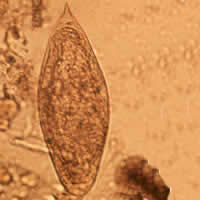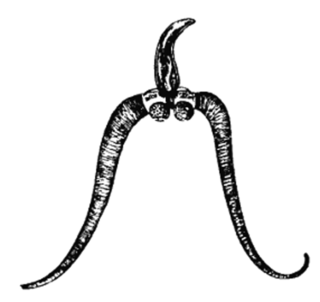| Pomphorhynchus | |
|---|---|
| Scientific classification | |
| Domain: | Eukaryota |
| Kingdom: | Animalia |
| Phylum: | Acanthocephala |
| Class: | Palaeacanthocephala |
| Order: | Echinorhynchida |
| Family: | Pomphorhynchidae |
| Genus: | Pomphorhynchus Monticelli, 1905 |
Pomphorhynchus is a genus of parasitic worms belonging to the family Pomphorhynchidae. [1]
The species of this genus are found in Europe and Northern America. [1]
Species: [1]
- Pomphorhynchus bosniacus Kistaroly & Cankovic, 1969
- Pomphorhynchus bufonis Fotedar, Duda & Raina, 1970
- Pomphorhynchus bulbocolli Linkins, 1919
- Pomphorhynchus bullockiGupta and Lata, 1968
- Pomphorhynchus cylindricaWang and Gu, 1983
- Pomphorhynchus dubiousKaw, 1941
- Pomphorhynchus francoisaeGolvan, 1969
- Pomphorhynchus jammuensisFotedar and Dhar, 1977
- Pomphorhynchus kashmirensisKaw, 1941
- Pomphorhynchus kawiFotedar, Duda and Raina, 1970
- Pomphorhynchus kostylewiPetrochenko, 1956
- Pomphorhynchus laevis(Zoega in Müller, 1776)
P. laevis is a parasitic acanthocephalan worm that can influence the reaction of its intermediate host, the freshwater amphipod Gammarus pulex, to the smell of potential predators like perch, Perca fluviatilis. P. laevis facilitates its movement from its initial host. Research has demonstrated that organisms affected by the parasite exhibit a diminished or inverted avoidance response to the scent of predators when compared to uninfested specimens, supporting the notion that the parasite manipulates its host, with the goal of passing itself on to its definitive host, a freshwater fish. Affected specimens also demonstrate vibrant changes in color, making them more visible to predators. This worm swells its proboscis to press microneedles into the intestinal wall, with a very strong adhesive force. This has inspired a structural skin graft adhesive that sticks strongly but has minimal tissue damage while in place and upon removal.
- Pomphorhynchus lucyiWilliams & Rogers, 1984
- Pomphorhynchus megacanthusFotedar and Dhar, 1977
- Pomphorhynchus moyanoiOlmes and Habit, 2007
- Pomphorhynchus omarsegundoiArredondo and Gil de Pertierra, 2010
- Pomphorhynchus oreiniFotedar and Dhar, 1977
- Pomphorhynchus orientalisFotedar and Dhar, 1977
- Pomphorhynchus patagonicusOrtubay, Ubeda, Semenas and Kennedy, 1991
- Pomphorhynchus perforator(von Linstow, 1908)
- Pomphorhynchus purhepechusGarcía-Varela, Mendoza-Garfias, Choudhury & Pérez-Ponce de León, 2017
- Pomphorhynchus rocciCordonnier & Ward, 1967
- Pomphorhynchus sebastichthydisYamaguti, 1939
- Pomphorhynchus sphaericusPertierra, Spatz and Doma, 1996
- Pomphorhynchus spindletruncatusAmin, Abdullah and Mhaisen, 2003
- Pomphorhynchus tereticollis(Rudolphi, 1809)
- Pomphorhynchus toriFotedar and Dhar, 1977
- Pomphorhynchus yamagutiiSchmidt and Higgins, 1973
- Pomphorhynchus yunnanensisWang, 1981
- Pomphorhynchus zhoushanensisLi, Chen, Amin & Yang, 2017









